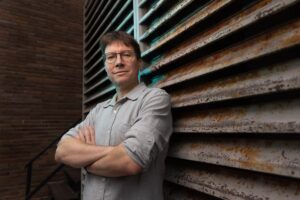
Hannah Cairo was stuck with a math problem. In those weeks he thought of nothing else and decided to try a new approach. “After months of trying to prove the result, I was able to understand why it was so difficult. I realized that if I used that information in the right way, I could disprove the claim. Finally, after several failed attempts, I found a way to construct a result counterexample (a case that doesn’t verify the property studied and that proves not to be true, in a general way).” Cairo says it required several tools, including fractals, and he had to place everything very carefully. “It took me a while to convince Ruixiang Zhang (the professor of the subject where the problem was raised) that my proposal was indeed correct,” Cairo says.
So it was, and with it Cairo solved the so-called Mizohata-Takeuchi conjecture, a problem proposed in the 1980s, which the harmonic analysis community had been working on for decades. Although it was expected to be true – if so, other important findings in the field would have automatically been resolved – the community greeted the result with enthusiasm. And with surprise: its author was a 17-year-old girl who had not yet finished high school.
“When I moved to the United States from Nassau (Bahamas, where he was born), I integrated into the education system as a high school student, even though I attended classes at UC Berkeley. I wrote to professors, told them what books I had read on the subject, and asked them if I could attend their classes. Many said yes, including Zhang,” he says. “One day, he proposed that I try a special case of the conjecture, which was much simpler, as a homework assignment. As an optional part, he proposed the original conjecture. And I became obsessed with it,” he adds.
The Mizohata-Takeuchi conjecture falls into the realm of harmonic analysis, which attempts to break down functions into simpler components, such as sinusoidal functions. Today it is a very hot area of research and has also become a fundamental tool in numerous applications, from the compression of digital audio and video files to the design of telecommunications systems.
Harmonic analysis was born in the early 19th century with the work of the French mathematician Joseph Fourier on the study of the heat function, a partial differential equation that describes the diffusion of heat in a solid body. His revolutionary idea was to decompose this complex function as the sum of sines and cosines. The technique, known as the Fourier series, opened the door to a new way of understanding physical and mathematical phenomena. “In the theory of harmonic analysis, everything is made up of waves. You can build anything with them, if you use an appropriate number of appropriate waves,” explains Cairo.
In restricted Fourier analysis we analyze what kind of objects can be obtained starting from only a small set of waves. “You can only build certain things, and it’s very difficult to figure out which ones. The Mizohata-Takeuchi conjecture says that if you only use certain types of waves, you get a shape made up of lines,” he explains.
“Once I had the first counterexample, I tried to reformulate the whole problem in frequency space. And I looked at how my construction looked like this. Then I realized that, in fact, there was another, much simpler way of designing a counterexample”, she declares satisfied in one of the rooms of the San José Residence, in El Escorial, where the 12 from 9 to 13 June took place. International conference on harmonic analysis and partial differential equationsorganized by the Institute of Mathematical Sciences (ICMAT) and the Autonomous University of Madrid. The event, known as El Escorial meetingshas become, in its almost 50 years of history, one of the most prestigious in the area.
This is Cairo’s first international scientific trip. Two weeks ago he landed in Barcelona and, since then, this is his fourth congress. “It’s a great experience to hang out with other people who like math,” she says. At the Escorial congress he gave one of the scheduled talks. And, far from feeling uncomfortable, she enjoyed it. Cairo likes to speak in public. She loves teaching other students, sometimes older than her. His vocation, he says, is “to help other people, to make them happy”. And, for as long as he can remember, he has been fascinated by mathematics.
He began to read complicated books on the discipline on his own. “I always wanted to do mathematics, but I didn’t know what it meant until I learned abstract algebra, through books. It’s funny, because abstract algebra is the opposite side of the mathematics I do now. Actually, at first I thought I would go into number theory. When I was thirteen or fourteen I wrote a paper on number theory, but it was about a problem that no one was interested in,” she recalls, laughing.
During the Covid pandemic, the Berkeley Mathematics Circle summer camp – a gathering where pre-college students try to collaboratively solve difficult math problems, similar to ICMAT’s Little Institute of Mathematics (PIM) – had to take place online. This allowed Cairo, from the Bahamas, to enroll in the course. “Maths clubs are for exploring and sharing your ideas with friends; they have nothing to do with school maths, where you have to memorize them. The work is similar to painting a picture with your ideas. It’s not about reaching a tangible goal, but just understanding things, asking questions, and it’s also a great way to make friends,” he explains.
The director of the program noticed Cairo’s extraordinary mathematical talent – another goal of this type of activity is to identify people with special skills in mathematics and encourage their interest and ability – and proposed that she become a teacher in subsequent editions. So he did. Now, at his new university in Maryland, where he will begin his doctorate next year, he hopes to start his own group.
There she will continue to work, directed by Zhang. “He helped me a lot and I am very grateful to him. In addition to his class, which I loved, he dedicated many hours of tutoring to me,” she recalls. In Spain, ICMAT’s new Intensive Mathematics Program (MIP) also seeks to identify and monitor trajectories of this type.
Agata Timón García-Longoria She is coordinator of the Mathematical Culture Unit of ICMAT.
Coffee and theorems is a section dedicated to mathematics and the environment in which it is born, coordinated by the Institute of Mathematical Sciences (ICMAT), in which researchers and members of the center describe the latest progress of this discipline, share meeting points between mathematics and other social and cultural expressions and remember those who marked its development and were able to transform coffee into theorems. The name evokes the definition of the Hungarian mathematician Alfred Rényi: “A mathematician is a machine that transforms coffee into theorems”.







